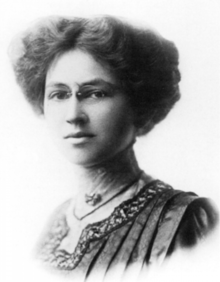Fanny Searls
Fanny Searls | |
|---|---|
 Searls c. 1870 | |
| Born | September 21, 1851 |
| Died | May 24, 1939 (aged 87) |
| Other names | Fanny Gradle |
| Education |
|
| Occupation | Physician |
| Spouse |
Henry Gradle
(m. 1881; died 1911) |
| Children | 2 |
Fanny Searls (September 21, 1851 – May 24, 1939), also known by her
Life
Searls was born on September 21, 1851, in Waukegan, Illinois, the daughter of Stewart Searls, a lawyer who operated from Chicago and Emily Cuthbert, the daughter of John Cuthbert, a physician. Her family descended from Jeremiah Searles, who had migrated from England to New York in the previous century.[1] She received her early schooling in the town, then attended the Northwest Female College in Evanston, Illinois, leaving with a Laureate in Science in 1870.[2]
She then entered
On August 30, 1881, she married Henry Gradle, an
Collecting career
In 1871, Searls accompanied her father to the Pahranagat Valley, Nevada, where she collected various rocks, fossils, quartzite with fragments of crinoids, and 215 botanical specimens. She handed this collection to Oliver Marcy at Northwestern University, who subsequently handed specimens to Asa Gray, who then described and published them.[2] Gray described four species:Chaenactis brachypappus A. Gray (Asteraceae), Penstemon caespitosus var. incanus A. Gray (Scrophulariaceae), Symphoricarpos longiflorus A. Gray (Caprifoliaceae) and Petalostemon searlsiae A. Gray (Fabaceae).[6] The last of these, now known as Dalea searlsiae, was a new discovery and was named the Searls' prairie clover in her honour.[7]
References
- ^ Lake City Publishing Company 1891, p. 306.
- ^ a b c Tiehm 1985, p. 41.
- ^ Kronfeld 1950, p. 606.
- ^ a b c Tiehm 1985, p. 43.
- ^ Moulton 1906, p. 100.
- ^ Tiehm 1985, p. 42.
- ^ St. John et al. 2011, p. 1.
Bibliography
- Kronfeld, Peter C. (1950). "Harry Searles Gradle, M.D. 1883–1950". A.M.A. Archives of Ophthalmology. 44 (4): 606–609. PMID 14770657.
- Lake City Publishing Company (1891). Portrait and Biographical Album of Lake County, Illinois Containing Full Page Ports. and Biographical Sketches of Prominent and Representative Citizens of the County, Together with Ports. and Biographies of All the Presidents of the United States and Governors of the State. Chicago: Lake City Publishing Company. OCLC 894892847.
- Moulton, Charles W. (1906). The Doctor's Who's Who. New York: O. Saalfield Publishing Co. OCLC 5971151.
- St. John, L; Tilley, D.; Ogle, D.; Johnson, D.; Bushman, D. (2011). Plant guide for Searls' prairie clover (Dalea searlsiae) (Report). Aberdeen, Idaho: USDA-Natural Resources Conservation Service, Plant Materials Center.
- Tiehm, Arnold (1985). "Fanny Searls (1851–1939)". Brittonia. 37 (1): 41–43. S2CID 87755152.
